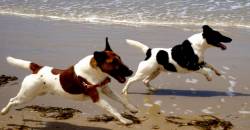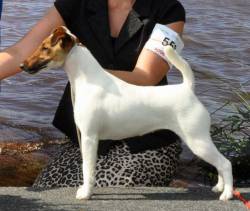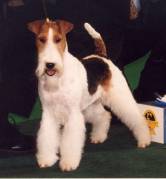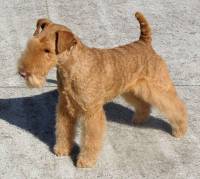Fox Terriers (Smooth and Wire)
 Fox Terriers (Smooth and Wire)
Fox Terriers (Smooth and Wire)
Historically called the 'Old English White Terrier', around 1800 the generic name 'Fox Terrier' was given to any Terrier that was used to bolt foxes out of their dens. This was particularly associated with the sport of Fox Hunting.
History of the Fox Terrier
 Fox Terriers c 1879
Fox Terriers c 1879
From 1863, classes for Fox Terriers of the old-fashioned type like those of the Parson Jack Russell were held at Shows and their pedigrees recorded in the First English Stud Book published in 1874, with their names based on show entries. At that time, coats on Fox Terriers ranged from smooth through to the rough.
 Fox Terrier (Wire) 1897
Fox Terrier (Wire) 1897
At that time, Parson Jack Russell was on the first board of the Kennel Club (UK) and one of the first Kennel Club judges despite his own dogs being specialised in Fox Hunting rather than show dogs.
The Fox Terrier becomes a Pure Breed
 Fox Terriers c 1907
Fox Terriers c 1907
In England, by 1900 Fox Terriers had become pure show dogs, bred quite separately from the Reverend Jack Russell's working terriers. As show dogs, winning Fox Terriers could attract higher prices than a hunting man or farmer could earn in a whole year. As Fox Terriers became show dogs, they were protected from the possibility of disfigurement to which working terriers were exposed.
In 1913 the Wire Fox Terrier Club of England was formed. Then coat type separated the registrations of the Fox Terriers into the 2 separate registries we know today into Fox Terriers (Smooth) and Fox Terriers (Wire).
History of the Fox Terriers (Smooth and Wire) in Australia
 Fox Terriers in Australia c 1900's
Fox Terriers in Australia c 1900's
In Australia Messers Bancroft exhibited Fox Terriers at Melbourne's first dog show in 1864[2]. When a Fox Terrier (Smooth) bitch named 'Careless' was brought to Sydney by Leonard Fosbery in 1868[3], a flood of imported Fox Terriers began. By 1883 the Australian Fox Terrier Club was formed, the first pure breed Club in Australia[1]. By 1910 an amazing 88 Fox Terriers had been imported into Melbourne and Sydney. In Melbourne, 13 of these went to Chas Lynott, 40 went to Walter Beilby, and another 11 went to NSW of which 7 went to Harry Moses[1]. This supplied a sound beginning from which 135 were recorded in Australia's first stud book.
Fox Terriers (Smooth)
 Fox Terrier (Smooth) 1975
Fox Terrier (Smooth) 1975
Smooth Fox Terriers bred here have since held their own against stiff competition created by many of our most famous breeders and judges. As a result, Smooth Fox Terriers have consistently been awarded Best Exhibit in Show all breeds throughout the country including at several of Australia's largest dog show, the Royal Melbourne Show. One of these was in in 1975 when the dog pictured, Ch Farleton Don Pedro won this Show from an entry of 5,680 individual dogs.
Fox Terriers (Wire)
 Jane aged 13 yearsIn Australia, unlike England, the earliest Wires were already split into a separate variety with the earliest importations recorded as coming from the Rev 'Jack' Russell's kennels. Another 15 followed with 48 separately listed in the Stud Book prior to 1912[1]. Today Fox Terriers (Wire) often win top honours at our major Australian Shows. On the right is me with my first dog, a Fox Terrier (Wire) given to me for my 10th birthday in 1948.
Jane aged 13 yearsIn Australia, unlike England, the earliest Wires were already split into a separate variety with the earliest importations recorded as coming from the Rev 'Jack' Russell's kennels. Another 15 followed with 48 separately listed in the Stud Book prior to 1912[1]. Today Fox Terriers (Wire) often win top honours at our major Australian Shows. On the right is me with my first dog, a Fox Terrier (Wire) given to me for my 10th birthday in 1948.
Fox Terrier Smooth and Wire Today
Today, a relic of the Fox Terrier's history is written into its breed standard where it is described like the horse called a hunter with which it used to work. The General Appearance says they should
" stand like a well made, short backed hunter, covering a lot of ground"
 Fox Terriers (Smooth)
Fox Terriers (Smooth)
Opinions vary as to whether the Fox Terrier (Smooth) and the Fox Terrier (Wire) are two varieties of the same breed or are two separate breeds which developed separately. But having been show dogs for a century and a half, breeders and judges alike have selected for exaggeration whilst still maintaining the basic construction of the long legged terriers. The modern Fox Terrier has an extremely short back compared to his ancestors and his head and neck have also become much longer.
 Fox Terrier (Smooth)
Fox Terrier (Smooth)
Whilst in both breeds an elongated head is sought, a flat skull topped off with button ears set high on the skull, combined with the long strong foreface make the Fox Terrier head very distinctive. They should move at a trot with balanced reach and drive. Both mention an ideal weight of 8 kg (18 pounds), and a height of not exceeding 39.5 cm (15.5 inches).
 Fox Terrier (Wire)
Fox Terrier (Wire)
The major difference between these two is the coat. Whilst the Smooth is smooth coated, the Wire has a broken coat which makes his outline outwardly appear similar to the Welsh and Lakeland Terriers (see the table below). Permissible colours in the Smooth are, white should predominate, all white, white with tan, black and tan or black markings. In the Wire although white should still predominate here should always be markings of black, black and tan or tan. Differences in conformation between the Fox Terrier (Smooth) and Fox Terrier (Wire) can be observed by diligent students and enthusiasts.
Comparison between Fox, Welsh and Lakeland Terriers
These 3 Terriers are directly compared here because although they appear alike, they differ not only in origin but also in several physical aspects. So it is important to compare these differences.
| Terrier | Fox Terrier (Wire) | Welsh Terrier | Lakeland Terrier |
|---|---|---|---|
|
|
|
|
|
| Background | Old English White Terrier (rough coated) | Old English Black and Tan Terrier (rough coated) | Terrier of the Border Region |
| Head Proportions | Little difference in length between skull and foreface | Medium length from stop to end of nose. Jaws rather deep. | Length of head from stop to tip of nose not exceeding that from occiput to stop |
| Ears | Top line of folded ears well above level of skull (Button Ears) | Set in fairly high and carried forward close to cheek | Set neither too high or too low on head |
| Chest | Deep not broad | Good depth and moderate width | Chest reasonably narrow |
| Body Proportions | Back short | Back short | Back moderately short |
| Height and Weight | Dogs not exceeding 15.5 inches at shoulder, bitches slightly less. Ideally 18 lbs. | Not exceeding 15.5 inches at shoulder. 20 - 21 lbs. | Not exceeding 14.5 inches at shoulder. Dogs 17 lbs, bitches 15 lbs. |
| Colour | White predominates with black, black and tan or tan markings | Black and tan or black grizzle and tan | Black and tan, blue and tan, red, wheaten, red grizzle, liver blue or black |
BREAKING NEWS.
We have now published a unique Terrier book 'Terriers Unveiled' Available at our sister site: https://rangeairevision.com/terriers-unveiled/
References and Further Reading
[1] 'Tyzack's Annual' Compiled by T. W.Tyzack and C.S.Turner Published by the Victorian Poultry and Kennel Club 1912 by Bellamine Bros. Printers, 66-70 Flinders Lane Melbourne Pages 93-96 (Importations) and 60-71 (Stud Book) Book of Chronicles Page 129.
[2] Catalogue of the First Exhibition of Sporting & Other Dogs, Thursday & Friday April 7 & 8, 1864 promoted by the Council of the Acclimatisation Society, printed in Melbourne by Mason & Firth, Printers, Flinders Lane West
[3] W.R.(Bill) Polley 'The Fox Terrier' self-published NSW circa 1980
Also published in 2012- Jane Harvey, "Fox Terrier and Jack Russells" in Lets Talk Terriers (Tracy Murphy, Dean Park NSW) Vol 8 No 2 2011 Pages 16 -18


